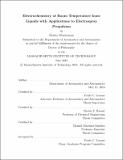Electrochemistry of room temperature ionic Liquids with applications to electrospray propulsion
Author(s)
Masuyama, Kento
DownloadFull printable version (14.73Mb)
Other Contributors
Massachusetts Institute of Technology. Department of Aeronautics and Astronautics.
Advisor
Paulo C. Lozano.
Terms of use
Metadata
Show full item recordAbstract
Room Temperature Ionic Liquids (RTILs) exhibit a number of physical properties that have opened new doors for technological advancements in space-based micropropulsion, focused ion beam, energy storage, and other research and industrial applications. As a family of concentrated electrolytes, RTIL electrochemical properties deviate from classical theories whose mean-field approach glossed over effects arising from the constituent ions' size and shape. Further development in the understanding of RTIL electrochemistry will drive better design towards enabling technologies, and this research contributes to the growing body of experimental data for RTIL electrochemical behavior with particular focus on applications towards electrospray propulsion devices. Electrochemical system behavior is governed by interfacial properties, in particular the electrical double layer (EDL). With no neutral solvent to fill the space between ions, the RTIL EDL takes on a complex, multilayered structure which lead to properties distinct from traditional aqueous electrolytes. A direct consequence of the layered structure is a differential capacitance curve that exhibits a local minimum at the potential of zero charge, flanked by two peaks followed by decaying wings. Recent modeling efforts have begun to capture these effects qualitatively, but require further tuning in order to quantitatively describe real systems. An electrochemical cell was designed to allow experimental measurement of capacitance curves, and the curves for two previously unreported RTILs are presented. The electro-chemical window is a limiting potential at which electrochemical reactions start. RTILs typically have large windows on the order of 4-6V, as compared to the 1.229V at which water begins electrolysis. In micropropulsion, a large electrochemical window allows for longer continuous operation without adverse reactions. In energy storage, this allows for higher energy capacity by the square of potential. Another way to increase emission duration or capacity is by increasing the available electrode surface area, so that more charge can be stored before breaching the stability window. Porous materials can provide enormous specific areas, with the carbonized resorcinol-formaldehyde synthesized in this work giving approximately 1m² g-¹ of electrode surface. Through a systematic comparison of this porous electrode and a flat metal electrode, it was confirmed that an electrode with mean pore size of approximately 2 [mu]m locally exhibits the same impedance as at a nonporous surface. Two electrospray emitter devices were used to study the charging dynamics of flat and porous electrodes under constant current charging. Electrode charging was observed to be governed not only by capacitance, but also by ion species, current polarity, current magnitude, and ion transport dynamics. Using the Scalable ion Electrospray Propulsion System, a 480-emitter thruster developed in the Space Propulsion Laboratory at the Massachusetts Institute of Technology, it was also shown that large charging currents saturated the effects of current magnitude and resulted in charging dynamics that collapse together when parametrized by surface charge density. The work concludes by using the observed trends to propose several guidelines for future electrode design in electrospray applications. Electrospray propulsion in particular promises to become an area of concentrated research as micro- and nano-satellites enter the market. Current propulsion systems cannot be effectively miniaturized for use on such platforms, but electrospray thrusters have demonstrated packaging in the 1 cm3 range including the fuel reservoir. In addition, the next step in the recently popular field of gravitational waves will employ space-based observatories, with the LISA Pathfinder technology demonstrator testing an RTIL-based propulsion system for its fine resolution control. It is the hope of the author that the work presented here will contribute to the further refinement of theoretical understanding of RTILs and provide guidance in the design of future RTIL-based technologies.
Description
Thesis: Ph. D., Massachusetts Institute of Technology, Department of Aeronautics and Astronautics, 2016. This electronic version was submitted by the student author. The certified thesis is available in the Institute Archives and Special Collections. Cataloged from student-submitted PDF version of thesis. Includes bibliographical references (pages 168-182).
Date issued
2016Department
Massachusetts Institute of Technology. Department of Aeronautics and AstronauticsPublisher
Massachusetts Institute of Technology
Keywords
Aeronautics and Astronautics.